Israel Abebe Azime
AFRIDOC-MT: Document-level MT Corpus for African Languages
Jan 10, 2025



Abstract:This paper introduces AFRIDOC-MT, a document-level multi-parallel translation dataset covering English and five African languages: Amharic, Hausa, Swahili, Yor\`ub\'a, and Zulu. The dataset comprises 334 health and 271 information technology news documents, all human-translated from English to these languages. We conduct document-level translation benchmark experiments by evaluating neural machine translation (NMT) models and large language models (LLMs) for translations between English and these languages, at both the sentence and pseudo-document levels. These outputs are realigned to form complete documents for evaluation. Our results indicate that NLLB-200 achieved the best average performance among the standard NMT models, while GPT-4o outperformed general-purpose LLMs. Fine-tuning selected models led to substantial performance gains, but models trained on sentences struggled to generalize effectively to longer documents. Furthermore, our analysis reveals that some LLMs exhibit issues such as under-generation, repetition of words or phrases, and off-target translations, especially for African languages.
Evaluating the Capabilities of Large Language Models for Multi-label Emotion Understanding
Dec 17, 2024Abstract:Large Language Models (LLMs) show promising learning and reasoning abilities. Compared to other NLP tasks, multilingual and multi-label emotion evaluation tasks are under-explored in LLMs. In this paper, we present EthioEmo, a multi-label emotion classification dataset for four Ethiopian languages, namely, Amharic (amh), Afan Oromo (orm), Somali (som), and Tigrinya (tir). We perform extensive experiments with an additional English multi-label emotion dataset from SemEval 2018 Task 1. Our evaluation includes encoder-only, encoder-decoder, and decoder-only language models. We compare zero and few-shot approaches of LLMs to fine-tuning smaller language models. The results show that accurate multi-label emotion classification is still insufficient even for high-resource languages such as English, and there is a large gap between the performance of high-resource and low-resource languages. The results also show varying performance levels depending on the language and model type. EthioEmo is available publicly to further improve the understanding of emotions in language models and how people convey emotions through various languages.
Uhura: A Benchmark for Evaluating Scientific Question Answering and Truthfulness in Low-Resource African Languages
Dec 01, 2024



Abstract:Evaluations of Large Language Models (LLMs) on knowledge-intensive tasks and factual accuracy often focus on high-resource languages primarily because datasets for low-resource languages (LRLs) are scarce. In this paper, we present Uhura -- a new benchmark that focuses on two tasks in six typologically-diverse African languages, created via human translation of existing English benchmarks. The first dataset, Uhura-ARC-Easy, is composed of multiple-choice science questions. The second, Uhura-TruthfulQA, is a safety benchmark testing the truthfulness of models on topics including health, law, finance, and politics. We highlight the challenges creating benchmarks with highly technical content for LRLs and outline mitigation strategies. Our evaluation reveals a significant performance gap between proprietary models such as GPT-4o and o1-preview, and Claude models, and open-source models like Meta's LLaMA and Google's Gemma. Additionally, all models perform better in English than in African languages. These results indicate that LMs struggle with answering scientific questions and are more prone to generating false claims in low-resource African languages. Our findings underscore the necessity for continuous improvement of multilingual LM capabilities in LRL settings to ensure safe and reliable use in real-world contexts. We open-source the Uhura Benchmark and Uhura Platform to foster further research and development in NLP for LRLs.
ProverbEval: Exploring LLM Evaluation Challenges for Low-resource Language Understanding
Nov 07, 2024



Abstract:With the rapid development of evaluation datasets to assess LLMs understanding across a wide range of subjects and domains, identifying a suitable language understanding benchmark has become increasingly challenging. In this work, we explore LLM evaluation challenges for low-resource language understanding and introduce ProverbEval, LLM evaluation benchmark for low-resource languages based on proverbs to focus on low-resource language understanding in culture-specific scenarios. We benchmark various LLMs and explore factors that create variability in the benchmarking process. We observed performance variances of up to 50%, depending on the order in which answer choices were presented in multiple-choice tasks. Native language proverb descriptions significantly improve tasks such as proverb generation, contributing to improved outcomes. Additionally, monolingual evaluations consistently outperformed their cross-lingual counterparts. We argue special attention must be given to the order of choices, choice of prompt language, task variability, and generation tasks when creating LLM evaluation benchmarks.
CVQA: Culturally-diverse Multilingual Visual Question Answering Benchmark
Jun 10, 2024



Abstract:Visual Question Answering (VQA) is an important task in multimodal AI, and it is often used to test the ability of vision-language models to understand and reason on knowledge present in both visual and textual data. However, most of the current VQA models use datasets that are primarily focused on English and a few major world languages, with images that are typically Western-centric. While recent efforts have tried to increase the number of languages covered on VQA datasets, they still lack diversity in low-resource languages. More importantly, although these datasets often extend their linguistic range via translation or some other approaches, they usually keep images the same, resulting in narrow cultural representation. To address these limitations, we construct CVQA, a new Culturally-diverse multilingual Visual Question Answering benchmark, designed to cover a rich set of languages and cultures, where we engage native speakers and cultural experts in the data collection process. As a result, CVQA includes culturally-driven images and questions from across 28 countries on four continents, covering 26 languages with 11 scripts, providing a total of 9k questions. We then benchmark several Multimodal Large Language Models (MLLMs) on CVQA, and show that the dataset is challenging for the current state-of-the-art models. This benchmark can serve as a probing evaluation suite for assessing the cultural capability and bias of multimodal models and hopefully encourage more research efforts toward increasing cultural awareness and linguistic diversity in this field.
IrokoBench: A New Benchmark for African Languages in the Age of Large Language Models
Jun 05, 2024

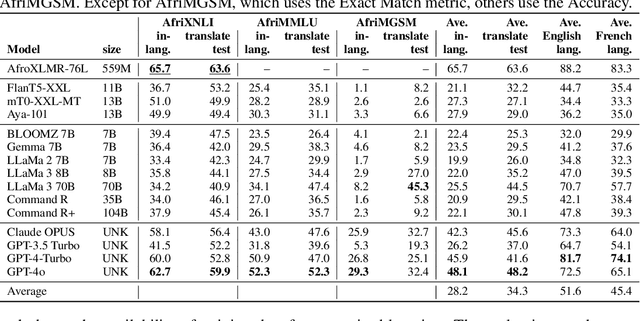

Abstract:Despite the widespread adoption of Large language models (LLMs), their remarkable capabilities remain limited to a few high-resource languages. Additionally, many low-resource languages (e.g. African languages) are often evaluated only on basic text classification tasks due to the lack of appropriate or comprehensive benchmarks outside of high-resource languages. In this paper, we introduce IrokoBench -- a human-translated benchmark dataset for 16 typologically-diverse low-resource African languages covering three tasks: natural language inference~(AfriXNLI), mathematical reasoning~(AfriMGSM), and multi-choice knowledge-based QA~(AfriMMLU). We use IrokoBench to evaluate zero-shot, few-shot, and translate-test settings~(where test sets are translated into English) across 10 open and four proprietary LLMs. Our evaluation reveals a significant performance gap between high-resource languages~(such as English and French) and low-resource African languages. We observe a significant performance gap between open and proprietary models, with the highest performing open model, Aya-101 only at 58\% of the best-performing proprietary model GPT-4o performance. Machine translating the test set to English before evaluation helped to close the gap for larger models that are English-centric, like LLaMa 3 70B. These findings suggest that more efforts are needed to develop and adapt LLMs for African languages.
EthioLLM: Multilingual Large Language Models for Ethiopian Languages with Task Evaluation
Mar 26, 2024



Abstract:Large language models (LLMs) have gained popularity recently due to their outstanding performance in various downstream Natural Language Processing (NLP) tasks. However, low-resource languages are still lagging behind current state-of-the-art (SOTA) developments in the field of NLP due to insufficient resources to train LLMs. Ethiopian languages exhibit remarkable linguistic diversity, encompassing a wide array of scripts, and are imbued with profound religious and cultural significance. This paper introduces EthioLLM -- multilingual large language models for five Ethiopian languages (Amharic, Ge'ez, Afan Oromo, Somali, and Tigrinya) and English, and Ethiobenchmark -- a new benchmark dataset for various downstream NLP tasks. We evaluate the performance of these models across five downstream NLP tasks. We open-source our multilingual language models, new benchmark datasets for various downstream tasks, and task-specific fine-tuned language models and discuss the performance of the models. Our dataset and models are available at the https://huggingface.co/EthioNLP repository.
Enhancing Amharic-LLaMA: Integrating Task Specific and Generative Datasets
Feb 12, 2024Abstract:Large language models (LLMs) have received a lot of attention in natural language processing (NLP) research because of their exceptional performance in understanding and generating human languages. However, low-resource languages are left behind due to the unavailability of resources. In this work, we focus on enhancing the LLaMA-2-Amharic model by integrating task-specific and generative datasets to improve language model performance for Amharic. We compile an Amharic instruction fine-tuning dataset and fine-tuned LLaMA-2-Amharic model. The fine-tuned model shows promising results in different NLP tasks. We open-source our dataset creation pipeline, instruction datasets, trained models, and evaluation outputs to promote language-specific studies on these models.
MasakhaNEWS: News Topic Classification for African languages
Apr 19, 2023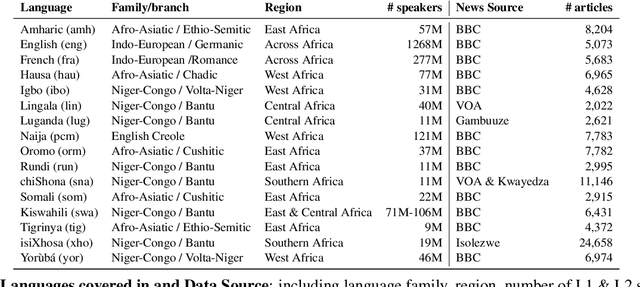
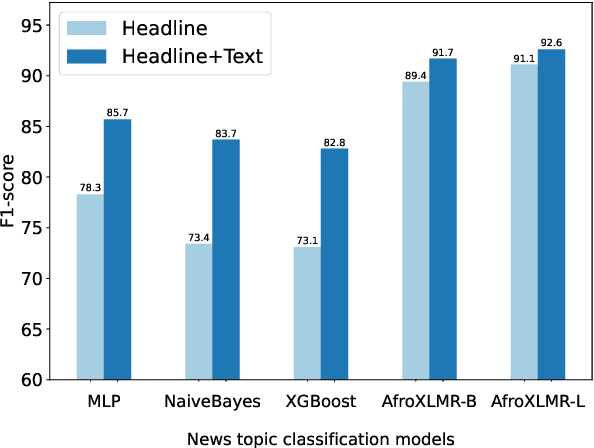
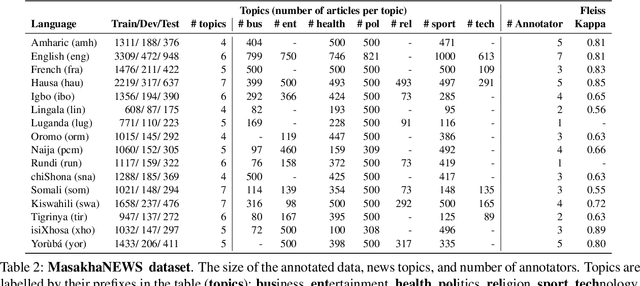
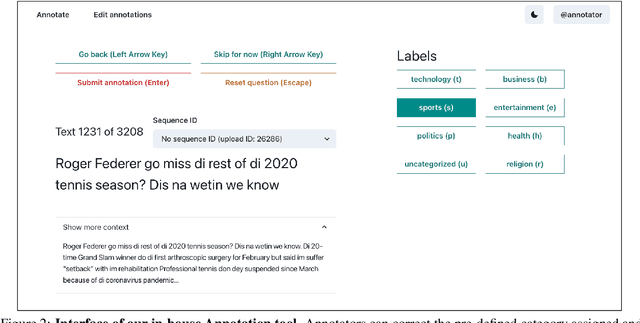
Abstract:African languages are severely under-represented in NLP research due to lack of datasets covering several NLP tasks. While there are individual language specific datasets that are being expanded to different tasks, only a handful of NLP tasks (e.g. named entity recognition and machine translation) have standardized benchmark datasets covering several geographical and typologically-diverse African languages. In this paper, we develop MasakhaNEWS -- a new benchmark dataset for news topic classification covering 16 languages widely spoken in Africa. We provide an evaluation of baseline models by training classical machine learning models and fine-tuning several language models. Furthermore, we explore several alternatives to full fine-tuning of language models that are better suited for zero-shot and few-shot learning such as cross-lingual parameter-efficient fine-tuning (like MAD-X), pattern exploiting training (PET), prompting language models (like ChatGPT), and prompt-free sentence transformer fine-tuning (SetFit and Cohere Embedding API). Our evaluation in zero-shot setting shows the potential of prompting ChatGPT for news topic classification in low-resource African languages, achieving an average performance of 70 F1 points without leveraging additional supervision like MAD-X. In few-shot setting, we show that with as little as 10 examples per label, we achieved more than 90\% (i.e. 86.0 F1 points) of the performance of full supervised training (92.6 F1 points) leveraging the PET approach.
Masakhane-Afrisenti at SemEval-2023 Task 12: Sentiment Analysis using Afro-centric Language Models and Adapters for Low-resource African Languages
Apr 13, 2023



Abstract:AfriSenti-SemEval Shared Task 12 of SemEval-2023. The task aims to perform monolingual sentiment classification (sub-task A) for 12 African languages, multilingual sentiment classification (sub-task B), and zero-shot sentiment classification (task C). For sub-task A, we conducted experiments using classical machine learning classifiers, Afro-centric language models, and language-specific models. For task B, we fine-tuned multilingual pre-trained language models that support many of the languages in the task. For task C, we used we make use of a parameter-efficient Adapter approach that leverages monolingual texts in the target language for effective zero-shot transfer. Our findings suggest that using pre-trained Afro-centric language models improves performance for low-resource African languages. We also ran experiments using adapters for zero-shot tasks, and the results suggest that we can obtain promising results by using adapters with a limited amount of resources.
 Add to Chrome
Add to Chrome Add to Firefox
Add to Firefox Add to Edge
Add to Edge